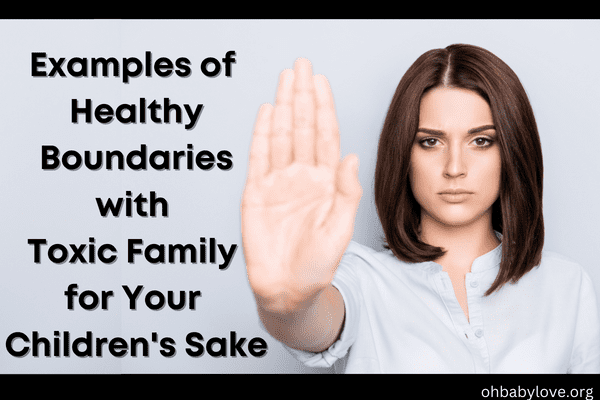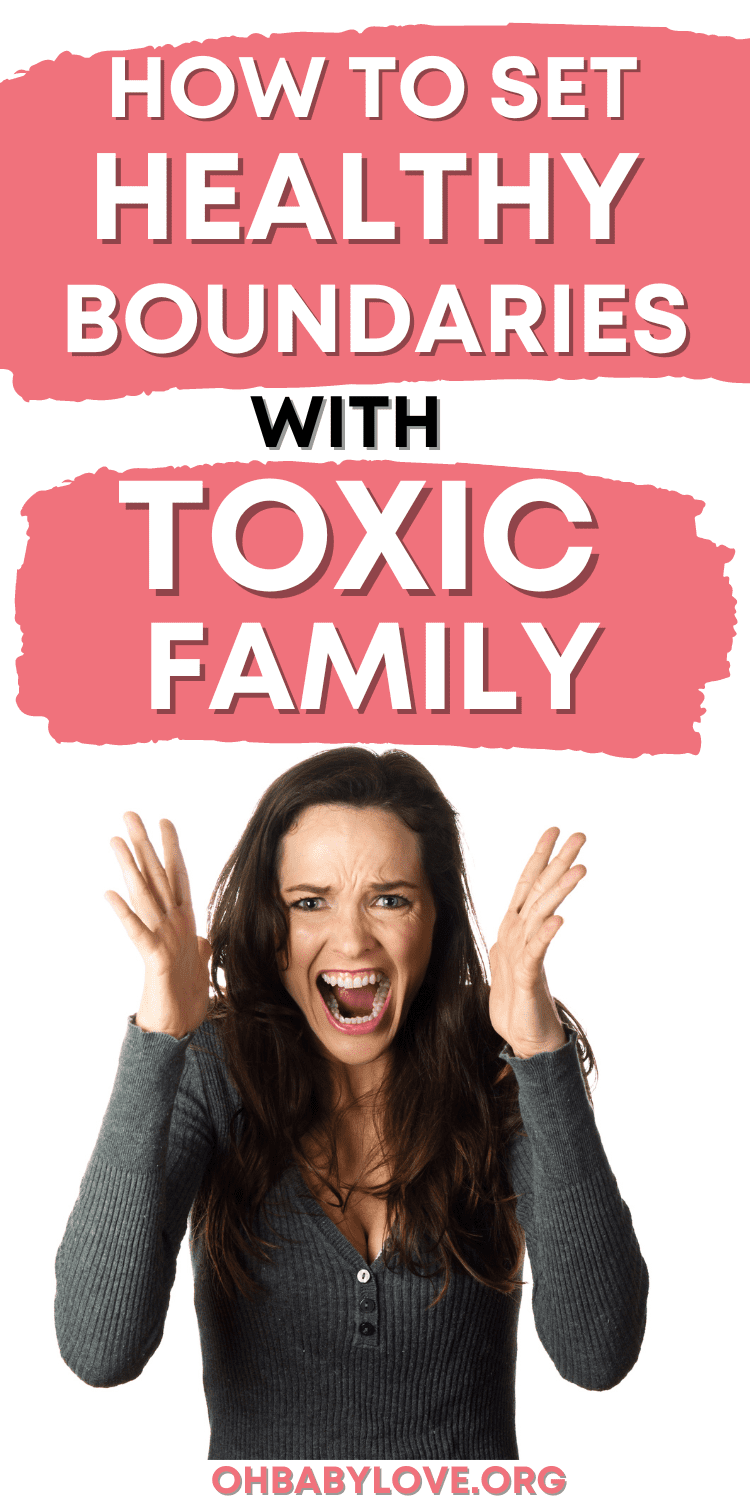We all have messy families. However, having children can put a magnifying glass over the dysfunction that you’ve lived with so far. When you have children that you are in charge of protecting, you can’t ignore the dysfunction anymore unless you want the dysfunction to continue its cycle down into the next generation.
When you have dysfunctional family members, meaning family members that have recurring toxic behavior that is not socially or biblically acceptable…Odds are these behaviors have been a part of them a really long time, way before you had children.
And now you are trying to navigate parenthood with your own children while you are surrounded by your toxic inlaws, parents, grandparents, aunts, uncles, cousins, and the list goes on.
I applaud you for wanting to make a change for your children. Your children have been entrusted to you and you are trying to do what is best for them. You want to model healthy behavior and interactions with them and others.
Children are so trusting and impressionable and while they are little, it’s your job to protect them and teach them the ways that they should go when it is time for them to be on their own.
So your options are to either cut toxic people out of your lives completely or to try to set healthy boundaries for you and your children. Cutting people out of your life for a season may be inevitable, but I implore you to exhaust creating healthy boundaries before you come to that decision. This blog post will hopefully give you some ideas on how to do that.
Included in this Healthy Boundaries Blog Post:
-How to Communicate with Dysfunctional Family Members
-Interacting with Dysfunctional Family Members
-Examples of Healthy Boundaries to Put in Place
-The Goal of having Healthy Boundaries
Setting Healthy Boundaries with Dysfunctional Family Members for Your Children’s Sake:
These boundaries are directly from our experience. My husband and I met with a licensed therapist and worked through our plan. First, we communicated to the dysfunctional family members what we would like to see happen.
We asked for 30 days of the boundaries listed below to be followed and then we would move forward to all of us meeting in person. Since we have young children, these family members wanted to be able to see the kids, and we want them to be able to see the kids as well. But we want it to be in a healthy way.
So, for those 30 days, we did not get together in person. It doesn’t have to be 30 days…it can be whatever you think is appropriate. And if inappropriate behavior still happens from them during this set time, you probably need to wait a little longer. Be serious about wanting change.
However, make sure you are communicating from a place of love. You should want restoration and a healthy relationship if that is possible. Make sure your family knows that you are not blameless and you are willing to make change too. It shouldn’t seem like you are towering above saying you are better than them and they must do certain things to be worthy of being in your presence.
It is possible to communicate in the midst of confrontation in a loving and compassionate way.
When You are Interacting with Dysfunctional Family Members…
Keep these things in mind when you are communicating and interacting with dysfunctional and/or toxic family members.
Communication: It is extremely difficult not to respond to a difficult family member with frustration. However, you are going to have to try to be the rational one to make this work.
For me, my husband has had to be the one to communicate to my dysfunctional family members because I’m too emotional. When a boundary needs to be communicated, my husband will tell them.
Grey Rock Method: Especially during the holidays, you will probably be around some family members that you normally wouldn’t volunteer to go spend time with. It’s going to be inevitable that tension brews during the holiday season when so many people get together.
The grey rock method enters the equation. It is what you use when you are dealing with manipulative behavior. When you know someone is poking at you, trying to get a reaction out of you…you don’t respond. You are a grey rock. You don’t give that person the satisfaction of the reaction they want.
They could be baiting you to make you also look irrational, but you stand firm and remain unengaged. Being unengaged doesn’t mean you don’t respond at all, but you give short and straightforward answers with no emotion. The point is that the person won’t get the reaction they want, and lose interest. For more information on the grey rock method, click here.
Examples of Healthy Boundaries with Dysfunctional Family Members:
Childcare: If you have family members with serious toxic and unhealthy issues, please do not let them babysit your children. You can still let your children around them with your supervision, but you need a different option than the unstable person being in charge of your children.
Make a List: When my husband and I needed to set healthy boundaries with extended family, he and I made a list. We had some “non-negotiables” that we needed our family to know that if they wanted us to come around, those things couldn’t happen anymore.
These things were communicated with as much grace as possible because our ultimate goal is restoration and healthy interactions.
Some of the things on our healthy boundaries list are:
-Please do not post any of your frustrations with us publicly on social media
-No texting at all. This had to be a rule for us because a lot of hurtful comments were coming our way through text messages.
People seem to be a bit braver when they are behind a keyboard, so for the time being…we had to ask for no communication through text messages.
-That any frustration would not be talked about in front of our children whenever we do get together. Not even quick passive-aggressive comments.
-Please not take their frustrations with us to other family members to try and get them involved and choose a side. When we’ve tried to set boundaries, we had tons of family come out of the woodwork to send us mean text messages based on a one-sided story they heard.
We, however, did not want to have additional family members involved because we didn’t want to cause division or he/said she/said situation. So we just stayed silent when hurtful comments would come our way because ultimately my husband and I know we are doing what is best for our family. And the people making hurtful comments didn’t know the whole story.
Depending on your situation, things on your healthy boundaries list might be:
-absolutely no drinking alcohol, smoking weed, etc when my children are around or before you are around them
-please do not use any cuss words, derogatory, or racial slurs when in the presence of my children
-when we are going to get together, if you could please let me know ahead of time who you are bringing with you
Examples of Healthy Boundaries for You and Your Children When You Get Together with Dysfunctional Family Members:
Meet in Public Places: When you are meeting with a dysfunctional family memberzj, I’d suggest meeting in public places while you are working towards healthy boundaries.
People tend to have better behavior when there are witnesses. This also means neither of you is stuck at the other’s house for long periods of time. You can start with just meeting for lunch or dinner, or meeting at a park.
This allows you to interact and see your family members, and for them to see your children without having to be at one another’s homes and it gives you a set amount of time for the interaction.
Your House: If things are going well enough that you do want to get together at one of your homes, start with your dysfunctional family member coming to YOUR house.
People seem to have this territorialness about being told how to act within their own homes. So if your family member were to start acting inappropriately and you mention it, you can avoid hearing “you’re going to tell me how to act in my own home” or something to that effect.
You Can Leave: If you are getting together with your dysfunctional family member and he/she isn’t attempting to follow any of the healthy boundaries you are trying to put in place…leave.
Don’t make a scene and huff off. You don’t even have to tell them the real reason you need to leave at that moment. Get out of there and collect yourself, give it some time, then reach out in communication to them about the healthy behaviors you are trying to model for your children. If they want to try to comply, give it some time, and try it again.

The Goal of Healthy Boundaries with Dysfunctional Family Members for You and Your Children:
The goal of these healthy boundaries is so that you can still have relationships with family members while protecting yourself and your children.
It is much easier to let go of friendships when you see the toll it is taking on you and your family, however, your family members will always be your family members.
It could be questioned that your children will resent you for keeping them from these toxic family members when they are older. You could be told that it’s not fair to your kids to withhold people from them.
However, your decisions for your children should not be out of anger, hurt, or a way to “get even” with anyone. Your decisions for your children should be because you are protecting them because they are too small to protect themselves right now.
Your decisions for them should be to shield them from dysfunction until they are equipped to make healthy decisions themselves. If they are older and resent you for not allowing them to be around their aunts/uncles/cousins/whoever then you will have to be okay with that because you were doing what was best for them at that age.
Also, again this plan above is steps to restoration and not to cut people out. It’s the middle ground for the polar opposites of living in the dysfunction or removing yourself completely.

When the Dysfunctional Person is Your Child’s Mother or Father:
This plan and suggestions are for family members who are not the mother or fathers of your children. These healthy boundaries are made for extended family members, because in divorces there are court orders where children are required to see the other parent for a certain amount of time, as long as the child is not in danger.
If this is your situation, I am so sorry. Having a dysfunctional co-parent must be incredibly difficult.
All you can do is show your children what a healthy household looks like when they are in your care. You can use some of the communication tips above to try to set healthy boundaries for yourself to approach things from a loving and compassionate place, at least on your side of things.
See if he or she would be willing to talk through some boundaries that are important to you when the children are in their care, but you have to be willing to also hear boundaries they want too. Then, hopefully, there can be some compromise.
Overview of Healthy Boundaries for You and Your Children with Dysfunctional Family Members:
No one in my life knows this blog of mine exists, other than my husband, so I didn’t create this post to expose the dysfunction we are working through.
But my husband and I have spent many hours working with a licensed therapist learning how to communicate and interact with dysfunctional family members. Since you are definitely taking an interest in how to raise your children in a healthy way, check out my blog post on raising kind children here.
Here are some great books to use as resources for a more extensive guide on how to deal with dysfunctional and toxic family members.
Coping with Critical, Demanding, and Dysfunctional Parents: Powerful Strategies to Help Adult Children Maintain Boundaries and Stay Sane

*Dysfunction and toxic people come in all different forms. This outline is based on what works for our family. There has not been any form of physical abuse in my family, but if that is part of the dysfunction you are living in, please please please look into some of these resources.
-Ways to Get Help for Violence
-National Domestic Violence Hotline: 800-799-7233
-National Domestic Violence Support Hotline
Follow Me on Pinterest ♥








